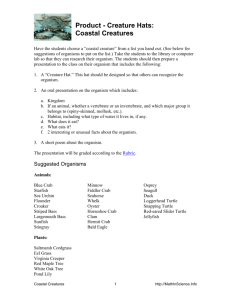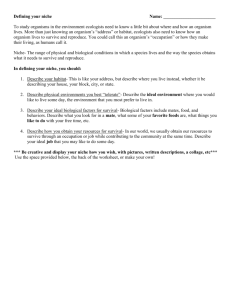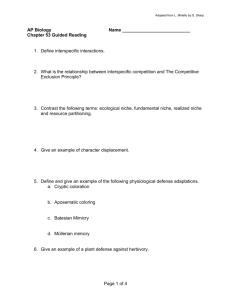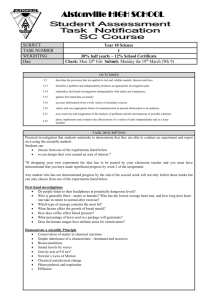Technology Achievement Standard
advertisement
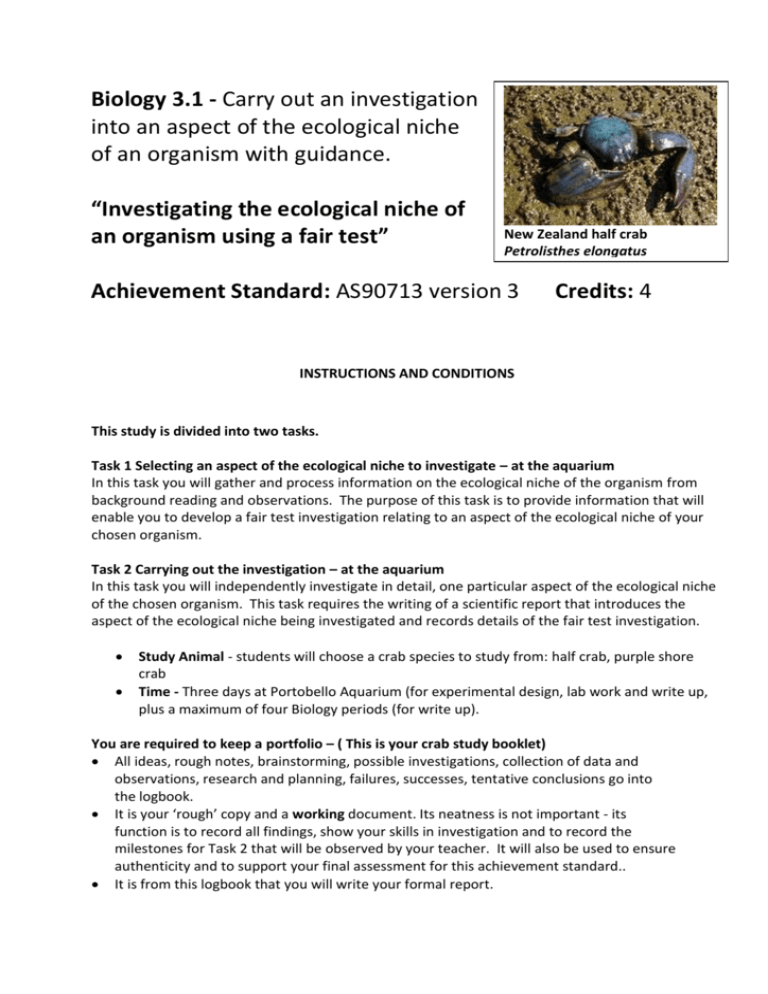
Biology 3.1 - Carry out an investigation into an aspect of the ecological niche of an organism with guidance. “Investigating the ecological niche of an organism using a fair test” New Zealand half crab Petrolisthes elongatus Achievement Standard: AS90713 version 3 Credits: 4 INSTRUCTIONS AND CONDITIONS This study is divided into two tasks. Task 1 Selecting an aspect of the ecological niche to investigate – at the aquarium In this task you will gather and process information on the ecological niche of the organism from background reading and observations. The purpose of this task is to provide information that will enable you to develop a fair test investigation relating to an aspect of the ecological niche of your chosen organism. Task 2 Carrying out the investigation – at the aquarium In this task you will independently investigate in detail, one particular aspect of the ecological niche of the chosen organism. This task requires the writing of a scientific report that introduces the aspect of the ecological niche being investigated and records details of the fair test investigation. Study Animal - students will choose a crab species to study from: half crab, purple shore crab Time - Three days at Portobello Aquarium (for experimental design, lab work and write up, plus a maximum of four Biology periods (for write up). You are required to keep a portfolio – ( This is your crab study booklet) All ideas, rough notes, brainstorming, possible investigations, collection of data and observations, research and planning, failures, successes, tentative conclusions go into the logbook. It is your ‘rough’ copy and a working document. Its neatness is not important - its function is to record all findings, show your skills in investigation and to record the milestones for Task 2 that will be observed by your teacher. It will also be used to ensure authenticity and to support your final assessment for this achievement standard.. It is from this logbook that you will write your formal report. TASK 1 - INVESTIGATING THE ECOLOGICAL NICHE OF A NAMED ORGANISM The ecological niche of an organism includes the physical conditions of the habitat (abiotic factors), the range of other organisms present (biotic factors) and how these link together to provide opportunities and threats for the organism. As well, the niche includes the adaptations that the organism has to allow it to exploit these opportunities and avoid the threats. Examine the ecological niche of the organism to provide information that could be used as a starting point for the development of a fair test investigation. (a) Habitat Examine the habitat of the organism using quantitative and/or qualitative data for factors (biotic and abiotic) such as: temperature aspect exposure light intensity other organisms present humidity density and age structure soil/substrate type (b) Adaptive Features Examine the adaptive features of the organism using background information and your own observations and measurements. The adaptive features may be related to: movement growth gas exchange nutrition sensitivity predators reproduction competition excretion Information on the ecological niche of the organism relevant to the aspect being investigated will later be written up to form the introduction section of your report. The introduction should be about one page in length. Purple shore crab – Hemigapsus edwardsii TASK 2 - INVESTIGATING AN ASPECT OF THE ECOLOGICAL NICHE OF A NAMED ORGANISM This task will form the main part of your Report. Focusing and Planning Using observations and information you have gathered in Task 1, select aspects of the organism’s niche for possible further investigation. The aspects of the ecological niche selected must be ones that are significant to the way of life of the organism. They must also provide you with the opportunity to develop and carry out an investigation that is appropriate to Year 13 Biology. a) In your logbook record aspects of the ecological niche that could be investigated. b) Formulate possible hypotheses for investigations relating to these aspects. c) Record ideas of how you could investigate these hypotheses. MILESTONE 1: Discuss your hypotheses and your ideas with your teacher. Your teacher will approve before you continue. d) Choose one hypothesis to investigate based on your discussion with your teacher. e) Use the information collected in Task 1 to write a brief summary of the ecological niche of your organism focussing on the aspect you are investigating and why it is significant to the way of life of the organism. Include information relevant to the hypothesis you have chosen to investigate. f) Initial method. Develop a step by step method for an investigation that will lead to a valid conclusion. Check that the equipment you want to use is available. You may need to trial some aspects of your investigation to ensure your method will be workable. MILESTONE 2: Submit your initial method and logbook to your teacher for checking. Your teacher will approve before you continue. Information Gathering g) Carry out your investigation. Record all relevant raw data accurately and clearly. Make sure you collect sufficient data to allow you to draw a valid conclusion MILESTONE 3: Evaluate the quality of the information gathered and its degree of relevance. Your teacher will approve before you continue. Processing and Interpreting Data h) Systematically record and process your data in a way that is appropriate to the type of data you have collected. i) Analyse your processed data to show trends, relationships or patterns relevant to your hypothesis. You are expected to use appropriate statistical procedures to establish the reliability of your data. j) Write a conclusion for your investigation. This must link to your data and to your hypothesis. MILESTONE 4: Discuss your analysis and conclusion with your teacher. Your teacher will approve before you continue. Reporting Using the information you have collated in your logbook, present your findings from Task 1 and 2 in a formal scientific report that includes the following sections: Title Aim Hypothesis Null hypothesis Introduction Method Results Conclusion Discussion Evaluation References Appendix A simple, brief description of your investigation. The purpose of your investigation. A statement predicting the outcome of your investigation. A corresponding statement that there will be no relationship between your variables. You refer to this when doing your statistical analyses. Relevant information on the species of crab you studied and its ecological niche. When writing this section, use the information in the Crab Study booklet, journal articles, and the initial investigations you did at Portobello. A set of instructions that clearly describes how your investigation was performed. This should be in enough detail that someone else could repeat your investigation. The method should be written in past tense and avoid personal pronouns, i.e., ‘I’ or ‘we’. Metric units should be used. You should list and describe the factors that you have kept constant. Present your raw data as a table or description. Present your raw data as a graph. (Remember clear headings and axes labels!) Statistically analyse your raw data, e.g. average, standard deviation, ANOVA. (Include a print out of your analysis as an appendix.) Accept or reject your hypothesis. Attempt to explain your results. Discuss your results, possible interpretations, what your results could mean,… Remember to link your results to the ecological niche of your species of crab! Refer back to your introductory essay. Justify the validity and reliability of your investigation. A list of all the sources you used. These must be footnoted in the body of your report. Your raw data and statistical analyses must be included as an appendix. Hand in your logbook with your report. Assessment schedule AS90713 version 1 Bio/3/1 – A version 2 To be awarded the grade (A, M or E) the student must meet the holistic judgement statement at the top of the column. Evidence towards Achievement The report and logbook show development of an investigation into an aspect of the ecological niche of an organism, appropriate recording and processing of data and conclusion and explanations linked to the purpose of the investigation. Development of an investigation: hypothesis linked to the ecological niche Independent and dependent variables Some other aspects of the investigation identified or described. Evidence towards Merit The report shows development of a feasible investigation into an aspect of the ecological niche of an organism, appropriate recording and processing of sufficient data, conclusion and evaluation or discussion linked to the purpose of the investigation. Investigation is feasible i.e. method can be followed to obtain relevant data. The method lacks some detail and cannot be independently followed without further clarification. Appropriate recording and processing Measurements or data from samples relevant to the purpose Data is accurately processed to enable a trend or pattern (or absence) to be interpreted. Method of processing is suitable to the hypothesis and type of data Sufficient data appropriately recorded and processed Data range or number of repeats will enable a reliable trend or pattern (or absence) to be identified. Conclusion links the findings of the investigation to the hypothesis and explains aspects of the investigation © Crown 2004 Conclusion links the findings of the investigation to the hypothesis. Evaluation OR Discussion Discussion: Knowledge of biological concepts or processes is used to discuss the biological significance of the results and how they relate to the ecological niche of the organism. Evaluation: analysis of the validity of the investigation Evidence towards Excellence The report shows development of a workable investigation into an aspect of the ecological niche of an organism, appropriate, systematic recording and processing of sufficient data, conclusion, critical evaluation and discussion linked to the purpose of the investigation. Investigation is workable i.e. method can be independently followed to obtain reliable data. hypothesis linked to the ecological niche appropriate range for the independent variable valid method for measuring the dependent variable describes how other variables will be controlled recognises the need for sufficient data eg repeated measurements, controls. Sufficient data appropriately and systematically recorded and processed Data presented can be interpreted without reference to the method Conclusion links the findings of the investigation to the hypothesis. Discussion: Knowledge of biological concepts or processes is used to discuss the biological significance of the results and how they relate to the ecological niche of the organism. Critical evaluation: Shows analysis and justification of the validity of the investigation OR reliability of the data (statistical analysis) 5 Excellence exemplar for Biology achievement standard 3.1 Introduction: The ecological niche of the crab Hemigrapsus edwardsi. The crab is a member of the Crustacea phylum and is in the family Grapsidae. This crab species is found only in New Zealand on rocky shores. The rocky shore, where the crabs studied in this investigation were found is quite exposed. There is a large rock platform that provides small crevices and small rocks which help to protect them from wave action and predators. There are also sea lettuce, and other algae growing on parts of the rocks. The crab has many adaptations that allow it to live on the rocky shore including: grey/black colour for camouflage food detection structures (antennae on its head and hairs on the mouth parts to sense chemicals in the sea water) 4 pairs of legs with muscles that allow it to move sideways, as well as forwards and backwards behavioural adaptations such as scuttling under rocks when the tide goes out or to avoid predators freezing when being attacked (we noticed this when we touched some of them on their backs). This might confuse predators. gills for gas exchange. The rock pools provide a micro-climate where the temperature and salinity of the water will change, depending on the weather. If it was a really hot day, the rock pools will get warmer, more water will evaporate and the salinity will increase. The crab would have to be adapted to cope with these changes in salinity, otherwise, as the concentration of salt in the water around it changes, it will gain or loose mass due to osmosis. Through the process of osmoregulation, the crab is able to maintain a constant water balance in its body, but to do so requires energy and this could be measured by an increase in the respiration rate. This is what I am going to investigate. Explains aspects of the ecological niche related to the investigation. The respiratory rate of the crab, Hemigrapsus edwardsi, in different salinities Aim: To determine whether the respiratory rate of the crab changes in different salinities. Hypothesis: The respiratory rate of the crab will increase as the salinity changes away Hypothesis linked to ecological niche from “normal” salinity. Controlled variables Method: Thirty crabs of similar size, were collected from the rocky shore. The salinity was varied by diluting the 200% conc. seawater provided in to five different concentrations. The volume of the solutions was 200mL each. The concentrations were 150%, 125%, 100%, 75%, 50% conc. Water with 100% concentration is equivalent to the concentration of Independent normal seawater. variable altered Sixty-five mL of the 150% solution was poured into a petri dish. The petri dish had a over an thin layer of stones in the base to recreate the natural environment of the crabs. appropriate range © Crown 2004 6 One crab was put into this petri dish and left for five minutes to allow them to adjust to the conditions. Controlled variables The petri dishes were floated on a water bath which was set at 180C. The water bath was placed in the room where the light intensity was the same for all petri dishes. Dependent variable An indirect method of estimating respiration was used. This was to count the number of currents seen on the surface of the water. I assumed that a higher number of currents indicated a higher respiration rate. A little bit of carmine red was sprinkled onto the solution in the petri dish in order to see the movement of water more clearly. The crabs were left in the petri dishes for five minutes before counting the respiratory currents. The respiratory currents were counted for 30 seconds. This amount was doubled to give the rate per minute. Sufficiency of data 5 more trials with different crabs were done at each concentration. Each time a fresh 65 mL of solution was added. The results were recorded and the rates per minute were averaged. This process was repeated for the 4 remaining concentrations and the results for these were averaged. Workable method outlined Results: Average respiratory rate of the crab in different concentrations of seawater. % concentration of the water (100% = normal sea water) 50 75 100 125 150 Average number of respiratory currents per minute 7.92 6.75 6.00 7.50 Sufficient data systematically recorded and processed. (raw data is in log book) 12.42 number of respiratory currents per min Average respiratory rate of the crab in different seawater concentrations. 14 y = 0.0016x 2 - 0.2908x + 18.648 r 2 = 0.9642 12 10 Data appropriately and systematically processed. 8 6 4 2 0 0 20 40 60 80 100 120 140 160 seawater concentration (%) © Crown 2004 7 Statistical analysis of results: The graph of the results suggests that there is a significant relationship between the concentration of the seawater and the respiratory rate of the crabs. This is confirmed by the r2 value of 0.9642, which indicates that 96% of the variation in the results is explained by the change in seawater concentration. Conclusion: The respiratory rate of the crab, as measured by respiratory currents, increased when the concentration of the seawater either increased or decreased from the 100% conc. (normal seawater). Discussion: This investigation was carried out to determine whether respiratory rates of the crab increased as the salinity was changed from normal levels. The crab is a euryhaline organism that lives on the rocky shore, often in rock pools. Because of the tidal movements of water, the salinity of the crab’s environment fluctuates. To maintain homeostasis, the crab osmoregulates. This means it actively controls the salinity levels inside its body. As the seawater concentration increased or decreased from the concentration of normal seawater (100% conc.) the respiration rate increased. This is because the crab is most comfortable at the concentration of normal seawater. As osmoregulation involves the active transport of ions, it requires energy to adjust to higher or lower seawater concentrations than 100% seawater. As the salinity of the crab’s environment increases or decreases from the salinity of normal seawater it requires more energy in order to osmoregulate. So in order to obtain that energy, it needs more oxygen and its respiration rate increases. This is necessary for the crab as it must deal with a range of salinity as the tidal pools dry out. If the concentration of the water is greater than that of the crab’s internal environment, it will go through osmosis. Although the crab has an exoskeleton, water can still leave its body through the space around its joints and gills. Evaluation: Initially I found that there were several problems with my investigation. The most significant one was that the crabs were out of their natural environment which made them more fidgety. Some of mine even attempted to escape from the petri dishes during the trials. This clearly shows that they were unsettled and perhaps not responding as they usually would. If they decided to stay inside the petri dish, they stayed close to the edge and moved away from the movement of people around them. I moved my investigation to a more secluded position and screened them off with a cover so that were not able to see what was around them. I also lined the petri dish with a thin layer of stones to attempt to somewhat recreate the natural environment. This change made the crabs calmer and produced a more natural response. Conclusion related to the hypothesis and extends it to reflect the range of the independent variable Significance of findings in relation to the ecological niche Discussion of results related to niche Critical evaluation limitations discussed and changes made to the method justified in relation to validity of investigation The counting of actual respiration itself was difficult as it was a humid day and the carmine red seemed to be congealing before being placed in the water. Perhaps in humid conditions chalk dust or very fine sand would have been more suitable but these were not available where I was carrying out the investigation. © Crown 2004 Critical evaluation through analysis of 8 the validity of the investigation Where the crabs were sampled from may have biased the outcome of the results as the position in the tidal zone might influence the levels of salinity that they were accustomed to. Most of my animals appeared to be female, this may also have biased my results. Further investigations would need to be carried out to determine if sex or original location influences crab respiration rate. Despite these limitations my results show that the increase in respiratory rates can be explained by the changing concentration of the seawater. © Crown 2004 9


